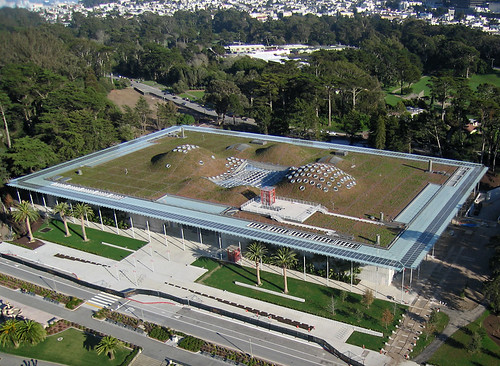Statements: Jeremy Rifkin, Foundation on Economic Trends
Jeremy Rifkin is the president of the Foundation on Economic Trends, he has written seventeen books on the impact of scientific and technological changes on the economy, the workforce, society, and the environment. GLOBAL IDEAS talked to him about ways to stop global warming, his new economic visions and the way we maybe need to change our way of life.
Double Platinum

It’s already called the world’s greenest museum…but it just got a little greener. The California Academy of Sciences in the U.S. opened in 2008 as a model of eco-friendly technology, and the U.S. Building Council gave it a platinum award. Now, the museum has won another – two times platinum, and as environmentally-conscious as ever.
The structure itself (right in the heart of Golden Gate Park) is an homage to sustainability and green living: it has a hilly, plant-covered living roof, insulation made of recycled denim, an entire canopy of solar panels and other green technology. And there’s a lot to see inside, too, like an aquarium, a planetarium and a natural history museum. National Public Radio in the U.S. did a report on the museum when it first opened, and they shared some amazing pictures here. Check them out!
Germany’s Electrifying Auto Industry

A new study by Jato Dynamics shows that Germany has the strongest market for electric cars so far in 2011. There were 1,020 new electric vehicles registered in the first half of the year in Germany – even though the country has one of the lowest government subsidies in Europe.
Why? Some experts believe the cost really has little to do with whether people buy electric cars or not – instead, people buying cars look at where they live, what the infrastructure is like and what a car is really worth.
But the good news is, EV (electric vehicle) sales in Europe in general have exploded in just a year’s time. There were more than 5,000 new electric cars registered in Europe in the first six months of 2011. That’s about 10 times – yes, 10 times! – as many EV’s as the first half of 2010. And as we saw at the Frankfurt Auto Show, the future for electric vehicles seems to be glowing brighter every day…
Solar Competition

Every 2 years, the U.S. Department of Energy hosts the Solar Decathalon in Washington D.C. It’s an international event where 20 different collegiate teams compete to see who can build the coolest, most energy-efficient, most stylish solar-powered home. As you can imagine, the students who take part are really inventive and creative, and the competition always boasts spectacular projects.
The New York Times already featured one team’s house, called the Empowerhouse, a ”shoebox-shaped mystery building.

The structure was put together in New Jersey by a team of students from the area using a combination of architecture, design, and green technology. The coolest thing? The house not only looks good, but it produces as much electricity as it uses every year – so a zero-emissions home.
But Empowerhouse is just one of the interesting designs being featured at this year’s Solar Decathalon competition. You can check out all the latest pictures and news, including news of the big winner when the competition ends, here.
May the best house win!
Turning orange peel into plastic?

Next time you eat an orange, think twice about chucking the peel into a bin – it might just help generate low-carbon plastic or energy in the future. An international group of scientists has come up with an innovative way of recycling food waste such as orange peel or coffee grounds.
Researchers at the universities of York, Sao Paulo and Cordoba have found that high-powered microwave heating can help activate cellulose in a variety of food waste, triggering the release of several chemicals. These include limonene, used in various household chemicals, and bio-ethanol which can be used as a substitute for diesel fuel. These chemicals could ultimately be used to make many of the chemicals and materials that we currently need oil for. And it could help tackle the growing problem of food waste.
The project called OPEC, or the Orange Peel Exploitation Company, plans to tie up with the juice-making industry in Brazil, a huge producer of orange peel residue. As a first step, there are plans to build a pilot plant in York that would process about 10 kilograms of waste per hour.








Feedback